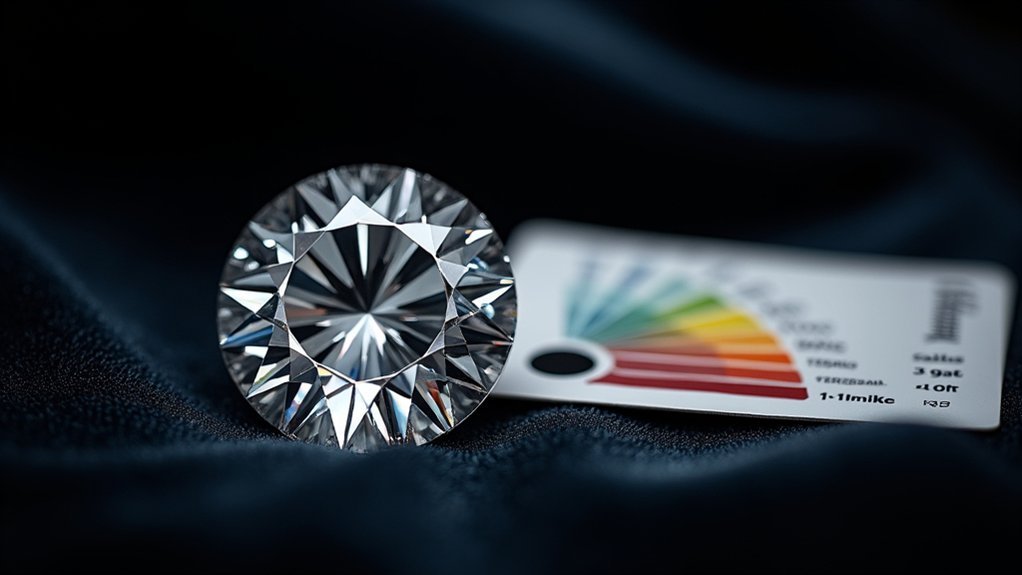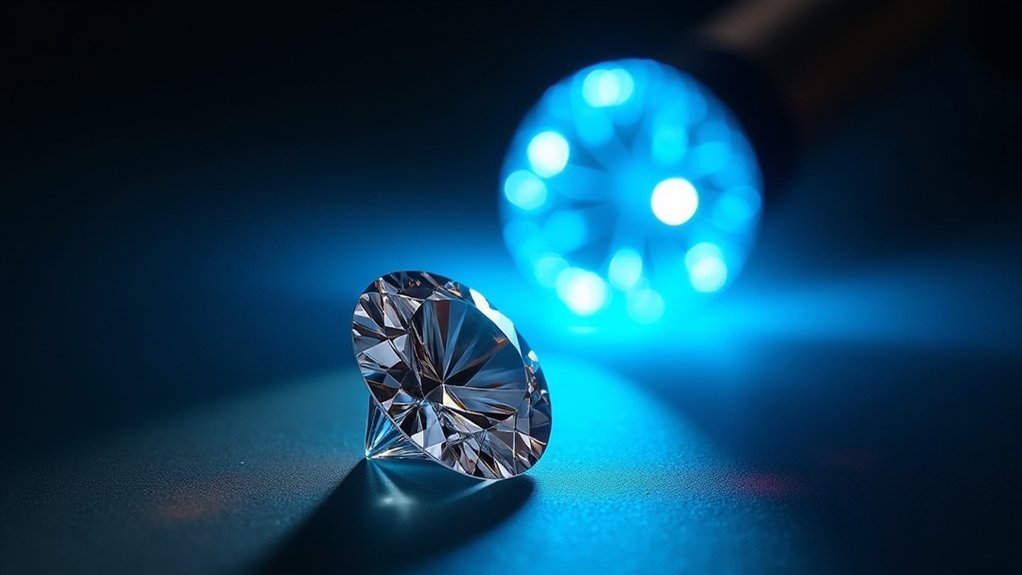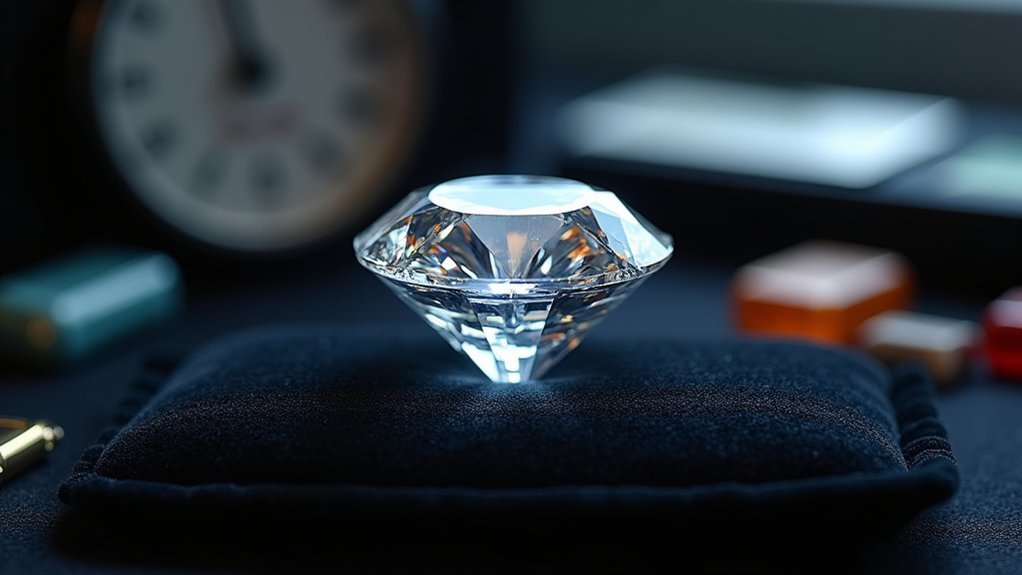You’ll achieve accurate diamond valuations by mastering these seven essential grading techniques: evaluate clarity under 10x magnification focusing on inclusion size and location, assess color against GIA’s D-Z scale using master stones in controlled lighting, analyze cut quality through light performance measurements, verify carat weight with calibrated scales, test for fluorescence effects on appearance, document findings with proper certification standards, and cross-reference unique ID numbers with laboratory databases. These professional methods guarantee you won’t miss critical factors that dramatically impact pricing and help you distinguish between stones worth thousands versus those with significant value reductions due to overlooked characteristics.
Understanding the GIA Diamond Grading Scale and Its Impact on Value

When you’re evaluating a diamond’s worth, the GIA Diamond Grading Scale serves as the industry’s most trusted framework, utilizing four essential factors known as the 4Cs—Clarity, Color, Cut, and Carat Weight.
Understanding this system is vital for grading diamonds accurately and determining fair market value.
Mastering the GIA grading framework ensures precise diamond evaluation and establishes credible market pricing for informed purchasing decisions.
Diamond clarity grades range from Flawless diamonds with no visible inclusions to I3 stones with obvious clarity characteristics.
Color grading spans D (colorless) to Z (noticeable tint), with colorless stones commanding premium prices.
Cut quality directly impacts brilliance and affects diamond price considerably.
Carat weight influences value non-linearly—larger diamonds cost exponentially more per carat due to rarity.
Each factor interconnects, making thorough evaluation essential for accurate assessment.
Color Grading Techniques for Optimal Diamond Assessment
You’ll need to master professional color grading standards that trained gemologists use with standardized equipment and controlled lighting conditions.
Understanding fluorescence impact becomes essential since blue fluorescence can mask yellow tints in lower color grades, while strong fluorescence might create a hazy appearance that reduces value.
Your assessment accuracy depends on using proper daylight-equivalent lighting and comparing diamonds against master stones to identify subtle color differences that markedly affect pricing.
Professional Color Grading Standards
Four key elements define professional color grading standards that’ll help you understand how experts assess these precious stones.
Professional color grading follows the industry standard GIA Color scale, where trained gemologists perform accurate assessment under controlled lighting conditions to eliminate external interference.
The grading process requires these essential components:
- Master stones – Reference diamonds representing each grade for consistent comparisons
- Standardized viewing environment – Neutral lighting that reveals subtle color differences
- Systematic evaluation – Face-down positioning against white backgrounds for objective analysis
You’ll find that professional graders carefully examine how blue fluorescence affects a diamond’s appearance, particularly in lower color grades where it may mask yellow tones.
This meticulous approach guarantees colorless diamonds receive proper premium pricing while maintaining accurate value assessments across all grades.
Fluorescence Impact Assessment
Three distinct lighting scenarios reveal how fluorescence dramatically alters your diamond’s color perception during professional assessment. You’ll notice strong blue fluorescence can counteract yellowish tint in lower color grading scale positions, potentially enhancing market value. When evaluating colorless diamond specimens, fluorescence may mask subtle differences that affect valuation.
| Fluorescence Level | Lighting Conditions | Diamond Appearance Impact |
|---|---|---|
| None | Natural sunlight | True color grade visible |
| Faint | UV light | Minimal color enhancement |
| Medium | Indoor fluorescent | Slight whitening effect |
| Strong | Direct sunlight | Noticeable color improvement |
| Very Strong | UV environments | Dramatic appearance change |
You must obtain a thorough GIA grading report documenting fluorescence assessment. This guarantees you’ll understand how lighting conditions influence your diamond’s appearance and overall valuation during professional evaluation.
Clarity Evaluation Methods Under 10x Magnification

When examining a diamond’s clarity under 10x magnification, you’re conducting the industry standard evaluation that determines its official clarity grade on the GIA clarity scale.
This assessment requires analyzing both internal inclusions and external blemishes based on their size, nature, number, location, and relief.
Trained gemologists evaluate these key characteristics:
- Size and visibility of inclusions – larger inclusions lower the grading scale position
- Nature of flaws – tiny crystals, feathers, or clouds affect appearance differently
- Location impact – central inclusions are more detrimental than edge placements
You’ll find that diamonds graded VS2 or SI1 often provide excellent value while remaining eye-clean.
Accurate assessments depend on consistent methodology, ensuring reliable clarity reports that maintain transparency in the diamond grading process.
Cut Quality Analysis and Light Performance Measurement
You’ll need to evaluate your diamond’s cut quality by examining how effectively it handles light through optical effects assessment.
Focus on analyzing the stone’s proportions and symmetry, as these directly impact how light enters and exits the diamond.
Pay special attention to brightness, fire, and scintillation – the three key optical phenomena that determine your diamond’s overall light performance and visual appeal.
Optical Effects Assessment
Although a diamond’s carat weight and clarity capture initial attention, its cut quality ultimately determines whether the stone will dazzle with exceptional brilliance or appear lifeless and dull.
When evaluating optical performance in cut diamonds, you’ll need to assess three critical visual elements that define diamond quality.
A well-cut diamond with precise proportions maximizes light reflection and delivers superior visual appeal through these optical effects:
- Brightness – White light reflection that creates overall luminosity
- Fire – Color dispersion producing rainbow flashes
- Scintillation – Dynamic sparkle patterns when the diamond moves
You can evaluate these characteristics through expert grading combined with visual inspection.
The interplay between brightness, fire, and scintillation reveals whether precise proportions have been achieved, directly impacting the stone’s market value and desirability.
Proportions and Symmetry
While optical effects reveal a diamond’s visual impact, the underlying proportions and symmetry determine whether those effects reach their full capability.
You’ll need to evaluate specific measurements when determining cut quality. Look for depth percentages between 59% and 62.5% and table percentages from 53% to 58% for ideal light performance and brilliance.
The GIA cut grading system provides standardized symmetry grades ranging from Excellent to Poor. You should prioritize diamonds with excellent symmetry grades, as they’ll reflect light more evenly across all facets.
Well-aligned facets maximize light return while minimizing leakage, directly enhancing the diamond’s optical effects.
When you’re conducting diamond grading, remember that excellent cut quality greatly impacts value. Superior proportions and symmetry create the foundation for exceptional brilliance, making these diamonds more desirable in today’s market.
Brightness Fire Scintillation
When evaluating cut quality, you’re measuring three distinct optical properties that determine a diamond’s visual performance: brightness, fire, and scintillation.
Brightness represents white light reflection, fire shows color dispersion, and scintillation creates sparkle through movement. These optical effects directly impact diamond valuation and value per carat.
The cut grading scale helps you assess light performance systematically:
- Excellent grade: Maximum brilliance with ideal light return
- Very Good grade: Strong performance with minor efficiency loss
- Good to Poor grades: Progressively reduced light interaction
Ideal cut diamonds achieve superior ratings across all three properties through precise proportioning.
You’ll notice exceptional brilliance when examining well-cut stones, as they’re engineered to maximize light performance.
Understanding these elements enables accurate assessment of a diamond’s visual appeal and market value.
Carat Weight Verification and Precise Measurement Standards
Since diamond valuation hinges on precise measurements, you’ll need to understand that carat weight operates on a metric system where one carat equals exactly 0.2 grams.
Diamonds are measured in metric carats and divided into 100 points, enabling accurate grading to the thousandth. You must use calibrated scales for accurately determining weight since minor discrepancies drastically impact diamond prices.
Larger stones command higher price per carat due to their scarcity. However, two diamonds with identical weight can have vastly different values based on cut, color, and clarity diamonds possess.
You should recognize “magic sizes” like 0.5ct, 1.0ct, and 1.5ct, which greatly influence consumer preferences and pricing.
Remember that precise measurement remains essential—even small variations affect your diamond’s overall valuation and market appeal.
Fluorescence Testing and Its Effect on Diamond Pricing

Although fluorescence often gets overlooked during diamond evaluation, it’s an essential factor that can greatly impact both the stone’s appearance and market value.
GIA grading reports include fluorescence assessments ranging from None to Very Strong, helping you understand this characteristic’s influence on diamond pricing.
Strong fluorescence can create beauty deficits in colorless diamonds, causing haziness that reduces visual appeal and resale value. However, blue fluorescence may mask yellow tones, affecting buyer perception by making lower-grade stones appear whiter.
Consider these fluorescence factors when evaluating diamonds:
- D-F colorless diamonds with strong fluorescence often sell at lower prices
- Faint or no fluorescence typically maintains higher market values
- Strong fluorescence may cause milky appearance in sunlight
Understanding fluorescence helps you make informed purchasing decisions and accurate valuations.
Documentation Requirements for Professional Grading Certificates
Beyond understanding fluorescence effects on diamond value, you’ll need proper documentation to verify your stone’s authenticity and quality. Professional grading certificates from reputable laboratories like the Gemological Institute of America guarantee accurate assessments. Your grading report should detail the 4Cs: Cut, Color, Clarity, and Carat Weight, providing thorough diamond quality evaluation.
| Documentation Element | Purpose |
|---|---|
| Unique ID Number | Verify authenticity against lab records |
| Visual Diagrams | Show inclusions and characteristics |
| Laboratory Seal | Confirm grading standards compliance |
| Detailed Measurements | Provide precise specifications |
Each certificate includes visual representations helping you understand your diamond’s characteristics. It’s essential to verify the laboratory’s grading standards and reputation, as different methodologies can create discrepancies in value. Always cross-reference the unique identification number with the issuing laboratory’s database for authentication.
Frequently Asked Questions
What Is the Best Grading System for Diamonds?
You’ll find GIA’s 4Cs system is the best for diamond grading. It’s globally recognized, standardized, and evaluates cut, color, clarity, and carat weight thoroughly. You can’t go wrong using GIA’s trusted methodology.
How to Tell if a Diamond Is Valuable?
You’ll determine a diamond’s value by examining the 4Cs: carat weight, cut quality, color grade, and clarity. Look for colorless stones with excellent cuts and minimal inclusions to maximize worth.
Which of the 4 C’s Is Most Important When Choosing a Diamond?
Cut’s generally most important since it controls your diamond’s brilliance and sparkle. However, you’ll want to balance all 4Cs based on your priorities—color and clarity also greatly impact appearance and value.
What Is the Ideal Diamond Grading?
You’ll want Excellent cut, G-H color, VS1-SI1 clarity, and strategic carat weight just below thresholds. This combination maximizes brilliance while balancing beauty and value without overspending on unnecessary premium grades.
In Summary
You’ve now mastered the essential techniques for accurate diamond grading. Apply these seven methods consistently to guarantee reliable valuations every time. Remember, precision in each step—from understanding GIA standards to documenting your findings—directly impacts your credibility and the diamond’s assessed value. Don’t rush the process; thorough evaluation using proper lighting, magnification, and measurement tools will distinguish your professional assessments from amateur attempts. Your expertise depends on meticulous attention to detail.





Leave a Reply